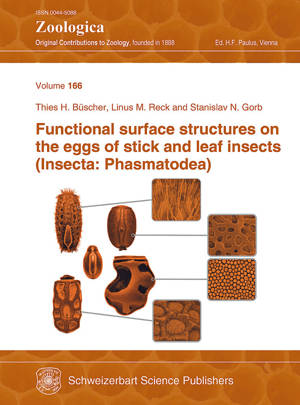
- Retrait en 2 heures
- Assortiment impressionnant
- Paiement sécurisé
- Toujours un magasin près de chez vous
- Retrait gratuit dans votre magasin Club
- 7.000.0000 titres dans notre catalogue
- Payer en toute sécurité
- Toujours un magasin près de chez vous
Functional surface structures on the eggs of stick and leaf insects (Insecta: Phasmatodea)
Thies H. Büscher, Linus M Reck, Stanislav N. Gorb
176,45 €
+ 352 points
Description
Volume 166 of Zoologica represents the first extensive comparative study of the egg surface morphology of stick and leaf insects (Phasmatodea). The eggs of 314 representative species are compared and described in detail, with particular focus on the functional surface structures. This study combines a review of egg surface structures of 126 taxa visualised in various literature sources and adds scanning electron microscopy investigations of 188 taxa visualised for the first time. The eggs of Phasmatodea stand out among insects, because of the mineralization of the layered egg shell. This egg shell is a structural basis, which is modified in multiple different ways to facilitate various functions of the surface of the egg. Phasmids occur worldwide and are adapted to different environmental conditions, this lineage arose as a model for the study of evolutionary scenarios and ecomorphological adaptations. The taxa considered cover a broad spectrum of phylogenetic lineages within Phasmatodea, the entire biogeographic distribution and different life history aspects of phasmids to facilitate investigation of relationships between the egg structures, ecology and phylogeny. There are three different levels of surface structures found in phasmid eggs that can be categorised by their morphology. The majority of the corresponding categories occurs convergently in several of the taxa considered, suggesting a high relevance of the ecological background of the species for the development of certain egg surface features. The functional relevance of all surface structures is discussed and evaluated with reference to previous studies of similar structures in other insect groups and artificial model systems. This study is of interest to biologists interested in biological surfaces, functional morphology, as well as the evolution, ecology and morphology of Phasmatodea. Furthermore, this monograph features a comprehensible description of the egg morphology of a high number of phasmid species, generously illustrated with high resolution scanning electron microscopy images, and therefore is a substantial reference work for future researchers working on this character system.
Spécifications
Parties prenantes
- Auteur(s) :
- Editeur:
Contenu
- Nombre de pages :
- 277
- Langue:
- Allemand, Anglais
- Collection :
- Tome:
- n° 166
Caractéristiques
- EAN:
- 9783510550531
- Format:
- Livre broché
- Dimensions :
- 230 mm x 310 mm
- Poids :
- 1360 g

Seulement chez Librairie Club
+ 352 points sur votre carte client de Librairie Club
Les avis
Nous publions uniquement les avis qui respectent les conditions requises. Consultez nos conditions pour les avis.






